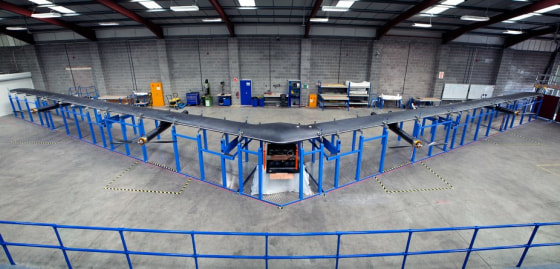Facebook has taken the wraps off the enormous solar-powered plane that may someday beam Internet to isolated communities. The Aquila (Latin for "eagle") is now complete and ready for flight testing, the company said. It has a wingspan of nearly 140 feet but weighs less than the average car, thanks to its carbon fiber construction — its "flying wing" design also makes it look something like a stealth bomber.
Related: Solar Impulse Pilot Andre Borschberg Breaks Solo Endurance Flight Record
Larger planes mean more weight, of course, but also more space for solar panels and more batteries for storing power. Solar Impulse 2, the solar plane currently making a pit stop in Hawaii on its round-the-world trip, has a 236-foot wingspan. "We probably had a look at about five or six sizes of aircraft," said Andy Cox, from Facebook's Aviation Team. "It got bigger every time."
The idea is that several Aquilas would enter the stratosphere above areas where Internet providers can't reach. Using lasers that could pinpoint a dime from 10 miles away, the Aquilas would communicate with a base station, each other, and the households receiving the Internet connectivity.
Related: Google's Solar-Powered Internet Drone Crashes During Test Flight
This project differs from other Facebook's Internet.org efforts, which have used the company's resources to sponsor access to existing infrastructure. The Aquila program is more research-oriented: "Our intention is not to build networks and then operate them ourselves, but rather to quickly advance the state of these technologies to the point that they become viable solutions for operators and other partners to deploy," wrote Jay Parikh, Facebook's vice president of global engineering and infrastructure, in a blog post about the Aquila.
"We still have a long way to go in this work, but we are excited by our early progress."

